The Centre’s nod to 12 world-class greenfield smart industrial cities at an investment of Rs 28602 crore, aligning with the vision of ‘Viksit Bharat’ will not only revolutionize India’s industrial landscape but also transform the real estate landscape in a big way.
This landmark initiative under the National Industrial Corridor Development Programme(NICDP) will create a grand necklace of industrial smart cities on the backbone of the Golden Quadrilateral, cementing India’s role in global value chains with ready-to-allot land for investors. These smart industrial cities will span across 10 states and have been planned strategically along 6 major corridors. The industrial hubs will be located in Khurpia in Uttarakhand, Rajpura-Patiala in Punjab, Dighi in Maharashtra, Palakkad in Kerala, Agra and Prayagraj in Uttar Pradesh, Gaya in Bihar, Zaheerabad in Telangana, Orvakal and Kopparthy in Andhra Pradesh and Jodhpur -Pali in Rajasthan.
Integrated development with ‘Plug & Play’ advantage
This landmark initiative is set to revolutionize how industrial and commercial spaces are conceived, developed and utilised. This monumental project, which promises to infuse ₹1.5 lakh crore into the economy and generate approximately 4 million direct and indirect jobs. This expansive vision encompasses 12 strategically located smart cities across 10 states, including major regions like Maharashtra, Uttar Pradesh, and Telangana. The project’s scale and ambition are evident in its design and goals, which focus on creating industrial hubs with a modern approach to urban planning.
One of the most compelling features of these new industrial parks is the “plug-and-play” infrastructure model. This concept aims to streamline business operations by providing ready-to-use industrial plots equipped with essential utilities and connectivity. This approach will significantly reduce the time and effort required for businesses to establish themselves, thus attracting a diverse range of investors—from large multinational corporations to innovative startups.
The efficiency and convenience of this setup are expected to catalyze rapid industrial growth. By minimizing bureaucratic hurdles and offering a seamless integration of infrastructure, these parks are poised to become highly sought-after locations for industrial activities. The focus on immediate operational readiness will appeal to businesses looking for efficient, cost-effective solutions for their expansion needs.
Residential and commercial real estate integration to boost demand
In addition to industrial development, the smart cities will incorporate the “walk-to-work” concept, promoting the integration of residential and commercial spaces. This innovative approach aims to redefine urban living by enhancing the quality of life. The inclusion of residential areas in proximity to workplaces will not only improve the convenience for employees but also foster a more sustainable urban environment.
This integration is likely to stimulate demand for commercial real estate in these smart cities. Businesses will seek spaces that align with the modern, efficient, and eco-friendly ethos of the new urban environments. Retail, hospitality, and service industries will benefit from the influx of residents and the increased economic activity generated by the industrial parks.
Boosting sustainability and inclusive urban development
Sustainability is a core principle of the NICDP, and the development of these smart cities reflects this commitment. The incorporation of green technologies and ICT-enabled utilities aims to minimize environmental impact while promoting efficient industrial operations. The focus on creating environmentally responsible industrial hubs will set a new standard for sustainable development in India.
The emphasis on green infrastructure aligns with global trends towards eco-friendly urban planning. As these smart cities become models of environmental stewardship, they will attract like-minded businesses and investors, further enhancing their appeal and sustainability.
The strategic location of these industrial parks across 10 states ensures a balanced regional urban development. The distribution of industrial parks along six major corridors will enhance connectivity and facilitate the efficient movement of goods and services. This integrated approach will strengthen regional economies and foster more interconnected and inclusive growth.
Looking Ahead
These 12 industrial smart cities mark a new chapter in India’s industrial and real estate sectors. As we look to the future, the impact of this initiative will be far-reaching, influencing everything from business operations to urban lifestyles. The project’s focus on efficiency, sustainability, and integrated development will set new benchmarks for industrial and commercial real estate.
For stakeholders across the real estate spectrum—investors, developers, and policymakers, the development of these smart cities represents an opportunity to engage with and contribute to a transformative, dynamic and efficient ecosystem for industrial and commercial real estate The implications for the real estate sector are profound, and the potential for growth and innovation is immense.
Enakshi Priyam, COO, Assotech Group



